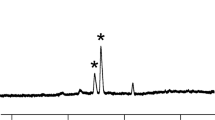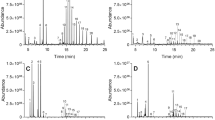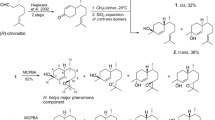Abstract
We investigated cues that mediate the aggregation behavior of immature pentatomid bugs by using nymphs of six different pentatomid bug species (Nezara viridula, Acrosternum hilare, Chlorochroa ligata, Chlorochroa sayi, Thyanta pallidovirens, and Euschistus conspersus). When first instars of any two species were put together in a Petri dish, they readily formed heterospecific aggregations similar to their natural conspecific aggregations. The chemical profiles of first and second instar nymphs of each species were determined by solvent extraction with pentane, followed by GC–MS analysis. Immature bugs of the different species had some compounds in common, and some that were more species specific. Within a species, there were distinct differences in the profiles of compounds extracted from first and second instars. Bugs did not aggregate around untreated polysulfone beads (1 mm diam) that were glued together in groups approximating bug egg masses, suggesting that tactile cues alone were insufficient to induce aggregation. Furthermore, when tested over a range of doses, groups of polysulfone beads treated with crude whole-body extracts of bugs did not induce or maintain aggregations. However, first instar N. viridula nymphs did respond to beads treated with two of the three major components of bug extracts. 4-Oxo-(E)-2-decenal induced significant aggregations at two doses, whereas tridecane, the major component in extracts from all six species, did not, and (E)-2-decenal was repellent. The repellence of (E)-2-decenal may explain why we and previous researchers were unable to induce aggregations of first instar N. viridula using whole-body extracts.
Similar content being viewed by others
REFERENCES
Aldrich, J. R. 1988. Chemical ecology of the Heteroptera. Annu. Rev. Entomol. 33:211–238.
Borges, M. and Aldrich, J. R. 1992. Instar-specific defensive secretions of stink bugs (Heteroptera: Pentatomidae). Experientia 48:893–896.
Ishiwatari, T. 1976. Studies on the scent of stink bugs (Hemiptera: Pentatomidae). II. Aggregation pheromone activity. Appl. Entomol. Zool. 11:38–44.
Kiritani, K. 1964. The effect of colony size upon the survival of larvae of the southern green stink bug, Nezara viridula. Jpn. J. Appl. Entomol. Zool. 8:45–53.
Lockwood, J. and Story, R. 1985. Bifunctional pheromone in the first instar of the southern green stink bug, Nezara viridula (L.) (Hemiptera: Pentatomidae): Its characterization and interaction with other stimuli. Ann. Entomol. Soc. Am. 78:474–479.
Lockwood, J. and Story, R. 1986. Adaptive functions of nymphal aggregation in the southern green stink bug, Nezara viridula (L.) (Hemiptera: Pentatomidae). Ann. Entomol. Soc. Am. 15:739–749.
Marques, F. D. A., McElfresh, J. S., and Millar, J. G. 2000. Female-produced sex pheromone of the predatory bug Geocoris punctipes. J. Chem. Ecol. 26:2843–2855.
Panizzi, A. R., McPherson, J. E., James, D. G., Javahery, M., and McPherson, R. M., 2000. Stink bugs (Pentatomidae), pp. 421–474, in C. W. Schaefer and A. R. Panizzi (eds.). Heteroptera of Economic Importance. CRC Press, Boca Raton, Florida.
Pavis, C., Malosse, C., Ducrot, P. H., and Descoins, C. 1994. Dorsal abdominal glands in nymphs of southern green stink bug, Nezara viridula (L.) (Heteroptera: Pentatomidae): Chemistry of secretions of five instars and role of (E)-4-oxo-2-decenal, compound specific to first instars. J. Chem. Ecol. 20:2213–2227.
Statsoft Italia. 1997. “Statistica per Windows. User's manual” Statsoft Italia S.r.l. Vigonza, Italy.
Author information
Authors and Affiliations
Rights and permissions
About this article
Cite this article
Fucarino, A., Millar, J.G., McElfresh, J.S. et al. Chemical and Physical Signals Mediating Conspecific and Heterospecific Aggregation Behavior of First Instar Stink Bugs. J Chem Ecol 30, 1257–1269 (2004). https://doi.org/10.1023/B:JOEC.0000030276.32665.cb
Issue Date:
DOI: https://doi.org/10.1023/B:JOEC.0000030276.32665.cb




